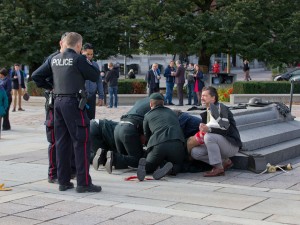 A colleague said, “You seem to resist uniformity. But some structure helps. Look at pre-printed orders. Docs love them!”
A colleague said, “You seem to resist uniformity. But some structure helps. Look at pre-printed orders. Docs love them!”
Good point.
Based on previous posts about bureaucracy and control, readers might assume I support medical anarchy, every doc doing his or her own thing. Not so.
Doctors love some rules and hate others. Sanity lies somewhere between totalitarianism and anarchy.
How can we find it?
Where’s the balance in healthcare?
Let’s use pre-printed order sheets (PPOs) as an example. Consider 4 types:
Medical Forms – Type I
Physicians create PPOs for common conditions. PPOs decrease effort, increase efficiency and improve quality and safety.
Front line physicians create forms to fit clinical work. The forms reflect and enhance clinical judgment. Favourite forms are so useful that physicians spend extra time looking around for them instead of trying to recreate them from memory.
Medical Forms – Type II
Often, ‘expert’ physicians will design PPOs to ‘help’ less-decorated physicians provide care. The experts generally do not work in the areas where their fancy forms get used.
Ivory tower physicians create forms for idealized environments and ideal patients. The forms cover every possibility. They are long, cumbersome and a waste of paper (or computer code). Docs sigh in relief when no one can find the PPO they were ‘supposed’ to use.
Medical Forms – Type III
Sometimes, allied health providers create PPOs and expect physicians to use them. They reflect thinking from non-medical care and demand actions physicians never take otherwise.
Docs go out of their way to avoid, undermine or directly sabotage these forms. They do not benefit patients when physicians use them.
Medical Forms – Type IV
Bureaucrats exist to bureaucratize and create forms. In fact, hospitals hire armies of administrators to respond to bureaucratic forms. As expected, bureaucrats create forms for physicians, too.
Bureaucrats’ forms contain a whiff of clinical overture but only enough to disguise their non-clinical purpose. These forms serve to ration care, audit or otherwise regulate medical work as measured against a theoretical ideal.
The worst bureaucratic forms block care unless the form is completed correctly (with copies). These forms waste time, frustrate providers and do not reflect the work done on the front lines. They limit care for other patients by the time required to complete them.
Intent
Dozens of other forms exist. Doctors like ones that make patient care safer and easier. Doctors hate forms that serve bureaucratic ends.
The difference is intent.
Healthcare innovation should always improve patient experience, efficiency, safety and quality. We should challenge change intended only to restrict freedom, save money or ‘limit variability’.
Bureaucracy, for its own sake, does not help patients.
Mindful Structure
Patients benefit when front-line providers – real-world experts – create processes and tools to improve care.
Doctors do not want anarchy. They want a healthcare system that facilitates the care they provide for patients.
Physicians need help. But helping physicians does not mean taking over. It does not mean telling doctors how to do their jobs. Too many confuse accountability with supervision.
Healthcare sanity lies in a system that supports providers in implementing solutions designed by providers for patients.
What do you think? Should central planners design ideal care and instruct doctors to deliver it? Are doctors oppositional defiant rogues?
Photo credit: productinnovationnow.com


